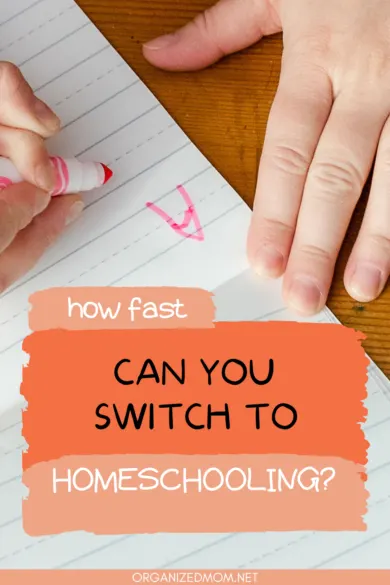Making a switch to homeschooling can be exciting and daunting for you and your child. However, many factors must be considered before making such a big decision. For example, suppose you are considering the transition to homeschooling seriously. In that case, you may wonder when the best time is to make the change and how long it will or should take.
Settling into a homeschooling routine can take up to six months. Other factors that can influence the length of the process include when you decide to start homeschooling, your state’s homeschool laws, and the process of withdrawing your child from school.
You can expect the switch to homeschooling to be a bumpy ride initially, but it is best to not give up in a hurry. It’s a significant change for everyone, and you will need a few months to tweak your schedule and curriculum. So, what does the switch to homeschooling entail, and why does it take almost half a year?
Making The Switch To Homeschooling As Fast As Possible
When you consider homeschooling as an alternative to public schooling, there are a few essential points to remember. Some steps are legal obligations, and others are centered around decision-making, open communication, and building a support network. So, let’s find out the fastest and best way to switch to homeschooling.
1. Discuss Homeschooling With Your Child And Family
There are many reasons why people choose homeschooling over mainstream schooling. However, regardless of the reason for choosing to homeschool, it should not be the decision of one person in the family. It should certainly not be a surprise for anyone, especially not a child used to mainstream schooling.
Whatever your reasons for considering homeschooling, it is best to make a move as soon as possible – even in the middle of a school or calendar year if necessary. The student, parents, and family should be on board and supportive as far as possible.
2. Research The State Laws On Withdrawal And Homeschooling
Each state’s laws surrounding homeschooling and withdrawing a child from a public school differ. Therefore, before you withdraw your child from school, you should familiarize yourself with the expectations and laws of your state.
Some states are stricter than others in their assessment expectations. For example, they may insist on standardized tests and portfolios to keep track of your child’s academic progress. Additionally, some states insist that the parent or homeschooling teacher has a minimum level of education.
The Homeschool Legal Defense Association (HSLDA) has a helpful website that provides the state laws on homeschooling. You can follow this link to view their page.
3. Request All The Relevant Records
When you withdraw your child from a school, you must submit a form to the school or state and request your child’s relevant records on file. The information should include attendance records, transcripts, school reports, and immunization details of the student. Hopefully, this process will take a short time to implement.
However, even if the school and state department takes longer than you’d like to fulfill your request, it is wise to be polite to the school at all times. You may need to contact them in the future, especially if your child will have to write standardized assessments with them or has to return for some reason.
4. Research Homeschooling Curricula And Get Connected
Before you choose a homeschooling curriculum, find out if there are other active homeschooling programs or organizations in your area. Then, connect with other homeschoolers to find out which curriculum they use and their pros and cons.
Switching from public schools to homeschooling can be an adjustment for your child, especially if they are socially or physically active or competitive. However, connecting with other homeschooling programs, students, and parents can provide some of the social interaction your child needs to thrive. Additionally, you might benefit from support during the good and trying times.
5. Plan Your Daily Schedule As A Guideline
A benefit of homeschooling is that it has a degree of flexibility to it. However, before you start homeschooling, it is wise to draw up a daily schedule that you can follow as a guideline. The program should include time for work, recreational activities, breaks, and social times.
What is convenient about homeschooling is that you can plan your schedule around your child’s most attentive hours. You can do schoolwork during these times and plan the rest of the school day around it. Importantly, you should refrain from trying to recreate a school environment at home; homeschooling should be firm but not too regimented.
As part of the daily schedule, you should include social visits with new and old friends to create a balance. Additionally, they may want to continue with sporting or cultural activities they enjoyed at public school. Just be careful to avoid over-committing to extra-curricular activities during the initial adjustment period.
6. Take A Break Before Starting With Homeschooling
Most homeschoolers suggest allowing your child a break before starting with homeschooling. This is especially true if you have begun the process mid-semester. Children need time to process the change from public school to their new tuition method, so a break of 2 to 4 weeks is recommended. This is especially true if public school affected them negatively.
During this break, you, as the parent, can prepare your lessons and gather any resources you’ll need. You can use the time to set up the new study area and make some fun memories. You can also do practical activities like baking or sewing. For example, if the child is technically minded, you can strip old appliances. You can also go for nature walks or visit a place of interest.
7. Allow Yourself Time To Adjust
If you have started with homeschooling mid-term, it is likely to take a bit longer to adjust than starting after a semester break. This is because your child will be used to a school routine and all that comes with it, so the switch will be quite an adjustment for them.
You and your child will go through a process of deschooling. Deschooling means adjusting to the alternative form of education to traditional schooling. During this time, you can cover the areas of tuition with which they struggled. You can also continue with practical activities like baking, playing games, or going for nature walks.
8. Be Kind To Yourself And Each Other
Before switching to homeschooling, it is best to accept that the process will not be idyllic. Some days you might feel like a failure or your child is non-compliant. There will be emotional days and days where very little work is done. But it’s ok! It’s a path you are walking together, and you’ve chosen it for a reason, so hang in there.
It’s best to start off simple and cover the basics or core subjects. If you started mid-year, you probably didn’t have enough time to plan everything to a T. On rough days, it’s ok to change plans. You don’t want to damage your relationship over school. As you adjust to this new venture, you can introduce other subjects and extra-curricular activities.
9. Additional Thoughts On Homeschooling
For some people, homeschooling is the best thing they could have done. For others, it might not be so. Suppose homeschooling hasn’t worked out for you. In that case, your child can reenter public school, as each state is legally obliged to provide free education to children.
This said, you must keep track of your child’s academic record. You will need it if your child reenters a public school or applies to study at college.
Additionally, should your child excel at homeschooling, it is best not to push them forward a grade too hastily. Instead, supplement their curriculum to make it more intriguing and challenging for them. A thorough understanding of the content is much more important than finishing the curriculum.
Conclusion
The switch to homeschooling can take up to six months. This includes taking time to plan and adjust to the new form of schooling. Of course, you can switch to homeschooling anytime during the school year. Still, it would help if you considered your state’s laws, the homeschooling curricula and support network available to you, and the needs of your child and family before doing so.




